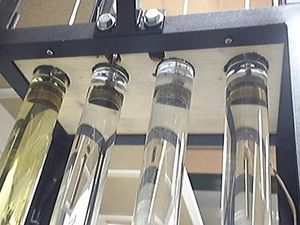Difference between revisions of "Liquid Pressure Variation with Depth"
| Line 1: | Line 1: | ||
===Description of the Experiment=== | ===Description of the Experiment=== | ||
| − | In this experiment, we determine the density of four different liquids taking | + | In this experiment, we determine the density of four different liquids taking into consideration that pressure variation with depth depend on it. |
<swf height="550" width="480">http://www.elab.tecnico.ulisboa.pt/anexos/descricoes-flash/Scuba.swf</swf> | <swf height="550" width="480">http://www.elab.tecnico.ulisboa.pt/anexos/descricoes-flash/Scuba.swf</swf> | ||
Revision as of 23:51, 10 November 2012
Contents
Description of the Experiment
In this experiment, we determine the density of four different liquids taking into consideration that pressure variation with depth depend on it.
<swf height="550" width="480">http://www.elab.tecnico.ulisboa.pt/anexos/descricoes-flash/Scuba.swf</swf>
Links
- Video: rtsp://elabmc.ist.utl.pt/scuba.sdp
- Laboratory: Básico em e-lab.ist.eu[1]
- Control room: scuba
- Grade: **
Experimental Apparatus
In this experiment there are four acrylic tubes with a diameter of thirty millimiters and a meter in length. Each tube is filled with a diferent liquid: distilled water, salty water, glycerin and vegetable oil. Inside each of these tubes there is a bell with air that allows pressure to be sensed through a flexible tube, which is attached to a pressure sensor located on the outside of the liquid.
The change in volume can be estimated considering that each bell has a volume of approximately \( 2 cm^3 \) and the hose has a cross-section of \(1 mm\) and a length of \(1 m\), but it can be easily ignored (why?).
The tubes are mounted vertically, and the four probes move simultaneously as established by the configuration chosen. The latter pause for a second at each measuring point to allow the pressure to stabilize before measuring. This will make the experiment run longer if the user requests many points.
Protocol
The user must define the following parameters: (i) maximum and (ii) minimum height and (iii) the number of samples to take across the pathway. This means that he can choose the initial and final depth for the probe's motion and obtain the data (for each liquid) on the variation of the pressure as the depth changes. Afterwards, the data can be fitted to the following equation, and from that, the density of the various liquids can be determined.
\[ p(h) = p_0 + \rho g h \]
If multiple runs are made (with different starting and ending points), the experimental error will be lower.
The following table shows the accepted values for the four liquid's density.
| Material | Accepted density (\( \frac{kg}{m^3} \)) |
|---|---|
| Water | \( 1,00 \times 10 ^3 \) |
| Glycerine | \( 1,26 \times 10 ^3 \) |
| Salty water | \( 1,03 \times 10 ^3 \) |
| Vegetable oil | \( 0,92 \times 10 ^3 \) |
Theoretical Principles
The pressure exerted by a liquid is proportional to the weight of the fluid column, meaning that it depends not only on depth but also on density. This can be determined through the relation between pressure and depth. This relation can be expressed mathematically by:
\[ p = p_0 + \rho g h \]
where \( p_0 \) represents the pressure at the liquid's surface and \( \rho = m/V\) it's density, being g the local gravity acelaration and h the depth. Recalling Pascal's principle note that \( p_0 \) is evenly distributed through the whole liquid.
